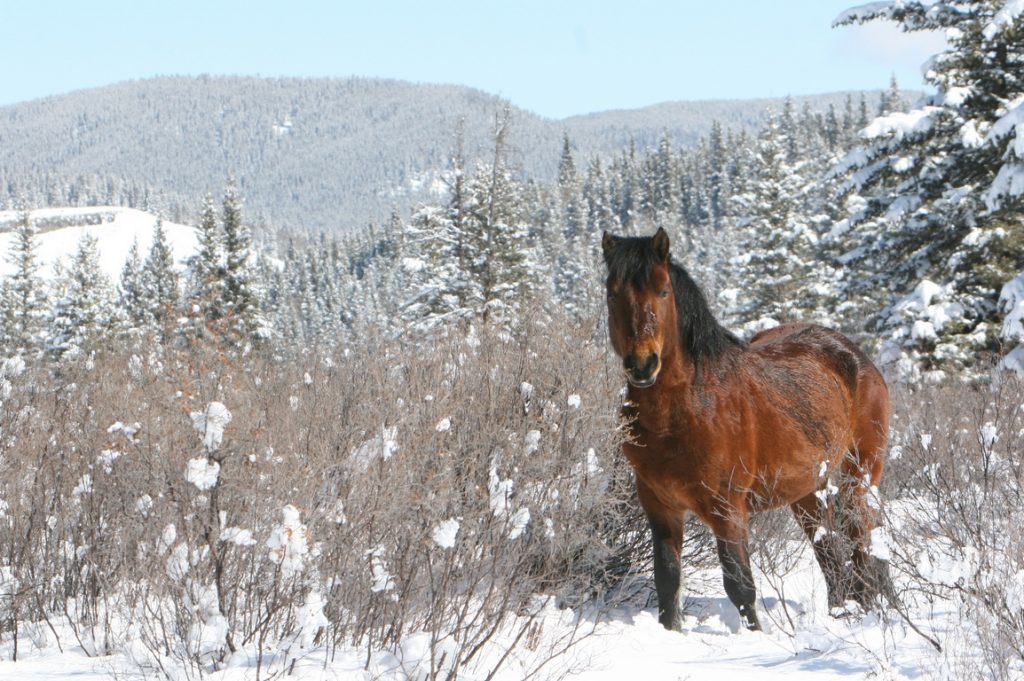
Wild horses do it, deer do, perhaps wild bees don’t do it but most creatures forage in the winter and so can you. Photo by the Wild Horses of Alberta Society.
It’s rather obvious that wintertime foraging varies where you live. In moderate Florida we can forage all year and the wintertime provides some of the best opportunities. But what of northern climates?
I grew up where winter night temperatures easily dropped into the 30-plus below zero (-38 celsius.) Sometimes the schools had to close for several days because they could not be kept warm. And once we went skating at 50 below just to say we did. (Chilblains from that night some 55 years ago still bother me in air conditioned buildings. It’s wasn’t the skating with a bonfire that did permanent damage but rather the arctic one-mile walk home.) That was on Gowen’s Pond, our local natural skating rink. It had one tree-stump island, probably had been a water-tolerant hackmatack. That speck of protrusion through the ice was perhaps six square feet in total area. The ice was thinner there and one winter I saw a turtle under the ice feeding some some green pond plant. That generated several thoughts. One was that it was warm enough for the turtle to go looking for food. Two that the turtle found food, and, three that the turtle was food. Like the turtle or the horses I grew up with you can find food in hostile winter climates if you know where to dig or browse. You can read more about that here.
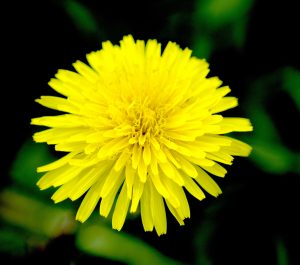
Dandelion blossoms are sweet, the green parts are bitter. Photo by Green Deane
Dandelions are an excellent example of an early summer northern plant that likes Florida’s winter. One can occasionally find Dandelions here all year but the temperatures are generally too hot. Also, Dandelions like acidic soil and Florida is a limestone door stop stuck under the North American plate. Cooler weather and acid-creating vegetation such as oaks and pines helps one find Dandelions. If you are used to northern Dandelions you might be disappointed in our local pretenders. Up north Dandelions can be 20-inches tall with huge blossom. If I find a Dandelion here that’s eight-inches tall it’s a large specimen. In the early ’60’s I made my first batch of home-made wine from such boisterous Dandelions, bottling it in returnable 12-ounce glass Coca-Cola bottles. The number of dandelion blossoms needed, about two gallons, were easy to collect. It would be difficult to find enough here. Mr. Gowen, the owner of the frozen pond mentioned above, came by one night and had a couple of bottles. The wine had it’s expected effects. There was something maniacally satisfying for a young teenager to watch an adult loosen up by drinking your wine. From there I moved on to brewing beer in the basement with a five-gallon crock and an oil lamp for heat. I was what? Thirteen? You can read more about Dandelions here.
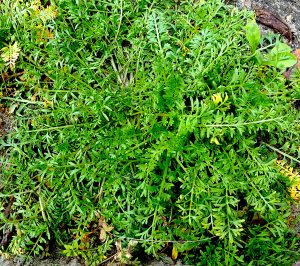
From a few feet above Swinecress can appear feathery. Photo by Green Deane
Another seasonal edible, Swinecress, was spotted this week in couple of locations. It’s low-growing and found mostly in lawns where it can duck most mowers. Swinecress is in the mustard family so the general taste is identifiable quickly. It’s among the few plants whose botanical name helps us identify the species. Sometimes a plant will have two names that honor two botanists which doesn’t help us with identification. Swinecress, however, is Coronopus didymus. Coronopus means Raven Foot, or we would say crow foot. To some, or at least the naming botanist, the leaf resembles a crow’s foot. And while that might be so it is the Didymus part that makes the plant easy to identify. Didymus means two testes and indeed it takes very little imagination to see that imagery in the arrangement of the species’ seeds. Once you see it you won’t forget it. Swinecress is edible raw or cook and only here for a couple of months. To read more about this micro-mustard go here.
Some people just make it tough for others. That’s the case with Sam Thayer and his foraging books. Each one lifts the bar higher making the mountain steeper for those with thoughts of authorship. Sam has published his third title, Incredible Wild Edibles: 36 plants that can change your life. ISBN: 978-0-9766266-2-6. His first two are Forager’s Harvest and Nature’s Garden.
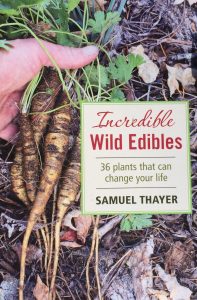
Incredible Wild Edibles
Besides being able to pick catchy titles Sam backs up the advertising with solid writing and good pictures. His third book has what we have come to expect — great specific plant write ups. This volume also delivers a good bit of foraging instruction and philosophy. In much of Sam’s writing I hear echos of my thoughts from where to forage to why some plants are called what they are called, common and botanical names. One of many irritating examples I can cite is Pinus palustris, literally swamp pine… It does not like to grow in perpetually damp soil. (And I won’t even get started on too many plants called “Pig Weed” “Indian Potato” or “Creeping Charlie.”) Sam in this latest edition also bravely marches into the emotional mind field of invasive species. When I am asked to speak before a Native Plant Society I am damned no matter what I say. Some native plant advocates don’t want to hear about edible native plants because those natives get eaten. Other native plant advocates only want to hear about edible natives because it presents natives positively. And still some native plant advocates don’t want to hear about edible non-natives because it presents non-natives as having some value. It’s like talking about eating Begonias before the National Begonia Society: Half the audience is thinking “Hmmm, begonias are edible” and the other half is thinking: “That bastard eats begonias.” When I hear a scream in my foraging classes it is always some native plant person having an emotional melt down over some species. All you can do, as Sam has done, is stake out a position and philosophy which is foragers can do a service regarding invasives. After all, who is closest to the plants? Most botanists don’t forage and many a “park ranger” doesn’t know what he or she is protecting, why, or if it is a good idea.
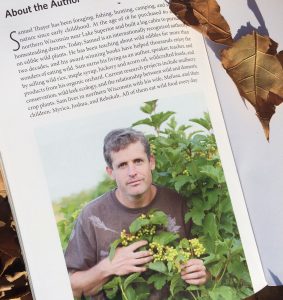
Incredible Wild Edibles is Sam Thayer’s Third Book
Reading Sam’s book helped me to dig out some old memories and new discoveries. Gooseberries were one. My mother liked to collect horses and that meant I was drafted to be groom, stall sweep, hay raker and riding companion. We used to wend along abandoned roads with forgotten homestead. Often by ramshacked 1800’s- homes we’d see gooseberries and their relative currants. A more recent discovery of mine that Sam covers is Thimbleberry. I don’t recall ever seeing it until I hiked parts of the Appalachian Trail in North Carolina. And Sam has a good section on “sugaring.” My indentured servitude with horses was compulsory. My salving over maple sugar was voluntary. Our neighbors in Maine sugared every spring and for many years I tapped, lugged, and boiled. My payment was always in maple syrup. As someone who has been low-carb for over a dozen years I’m not sure I would work so willingly now but it was a fine endeavor for a boy or anyone one who wants to get close to some trees and the work of making your own food.
You may think that now is not the time to think of foraging but it is. Winter will give way to spring. Sam’s third book with 36 new plants has no overlap with his first two books so you’re getting maximum information for the price. Buy the book now so when the snow is gone you are ready. Get it inside your head and get a jump start on the foraging season. Sam’s website is here.
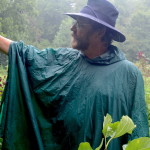
Classes are held rain or shine or cold…
Foraging Classes: Saturday’s class in Eagle Lake should be interesting. It a request for me to hold a foraging class in a place I’ve never visited. So when I say meet near the bathrooms near the dog park I will be looking for them as well. I don’t know how far we will walk nor what parts of the park we will visit. The point is to hold a foraging class site unseen. So if you want to see how I find edibles it’s a class to attend. It’s going to be an adventure treasure hunt and a fun way to end out the foraging year.
Saturday, December 30th, Eagle Park Lake, 1800 Keene Road, Largo, FL 33771. 9 a.m. Meet near the bathrooms near the dog park.
Saturday, January 6th, Blanchard Park, 10501 Jay Blanchard Trail. Orlando, FL., 32817. 9 a.m. We meet next to the WMCA building at the tennis courts.
Sunday, January 7th, Dreher Park, 1200 Southern Blvd., West Palm Beach, 33405, 9 a.m. We meet just north of the science center parking lot.
Sunday, January 21st, Bayshore Live Oak Park, Bayshore Drive, Port Charlotte. 9 a.m. Meet at the parking lot at the intersection of Bayshore Road and Ganyard Street.
To read more about the classes go here.
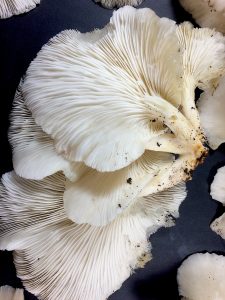
Quite a few white mushrooms that like to grow on wood. Photo by Green Deane
Most local edible mushrooms are waiting for warmer weather. Our Ringless Honey Mushroom season ended a few weeks ago. Most of our species will stay hidden until heavy spring rains. However during a foraging class this weekend we did see some Amanitas, of which there is no shortage of in the southeast. It was three examples of the same species, A. citrina. But the big surprise was a log of Oyster Mushrooms. While finding them on a downed tree is not unusual I had not seem them this time of year. Checking with some fungal friends we confirmed their identity as in the Pleurotus ostreatus complex. They say “complex” because the details of the mushroom can vary. I’ve seen them on oaks in the fall and Red Bays in the summer but not on an Ear Tree in winter. Oyster Mushrooms — which do not taste like oysters but can smell like anise — are considered one of the safer mushrooms to harvest because none of the possible look-a-likes are deadly… just sickening. And here’s a reminder that several facebook mushroom pages are associated with EatTheWeeds. They are Florida Mushroom Identification Forum, Southeastern U.S. Mushroom Identification, Edible Mushrooms: Florida, and the Orlando Mushroom Group which will start having mushroom hunts as soon as the season starts.

Green Deane Forum
Want to identify a plant? Looking for a foraging reference? Do you have a UFO, an Unidentified Flowering Object you want identified? On the Green Deane Forum we chat about foraging all year. And it’s not just about warm-weather plants or just North American flora. Many nations around the world share common weeds so there’s a lot to talk about. There’s also more than weeds. The reference section has information for foraging around the world. There are also articles on food preservation, and forgotten skills from making bows to fermenting food. One special section is “From the Frightening Mail Bag” where we learn from people who eat first then ask questions later. You can join the forum by clicking on “forum” in the menu.
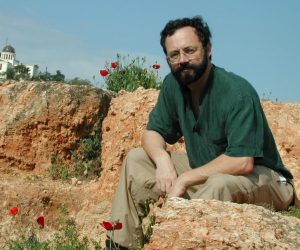
The Nine DVD set includes 135 videos.
All of Green Deane’s videos available for free on You Tube. They do have ads on them so every time you watch a Green Deane video I get a quarter of one cent. Four views, one cent. Not exactly a large money-maker but it helps pays for this newsletter. If you want to see the videos without ads and some in slightly better quality you can order the DVD set. It is nine DVDs with 15 videos on each for a total of 135 videos. Many people want their own copy of the videos or they have a slow service and its easier to order then to watch them on-line. The DVDs make a good gift for that forager you know especially on long, cold winter months. Individual DVDs can also be ordered or you can pick and choose. You can order them by clicking on the button on the top right hand side of this page (if your window is open wide enough.) Or you can go here.
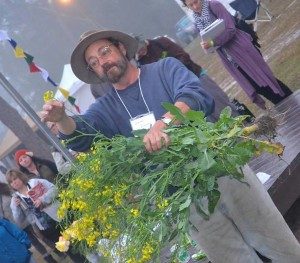
Green Deane teaching at a Florida Herbal Conference
It’s time to be thinking about two conferences in February, Earthskills in Hawthorn, and the Florida Herbal Conference near Lake Wales. I lead plant walks at both events. Earthskills is Feb 7-11 and the Florida Herbal Conference is Feb 23-25. Both are now accepting registration. You can register at Earthskills here. Because you read this newsletter you can get a discount for the Florida Herbal Conference. If you register for that conference between now and January 31 using the code FHC2018_GREENDEANE you can get a 30% discount. Keynote speakers this year at the Florida Herbal Conference are Linda and Luke Black Elk from the Standing Rock Reservation. Linda (of the Catawba Nation) is an ethnobotanist specializing in teaching about culturally important plants and their uses as food and medicine. She is a lecturer at Sitting Bull College in Fort Yates, North Dakota. Luke Black Elk (Thít?u?wa? Lakota) is a storyteller, grassroots activist, and traditional spiritualist. He has conducted research in water restoration, sustainable building design, and food sovereignty, and hopes to use these techniques to encourage a more traditional way of life among his people. Luke has lived on the Cheyenne River Sioux Reservation his entire life, becoming deeply involved in cultural and community activities. For more information about the Florida Herbal Conference go here.
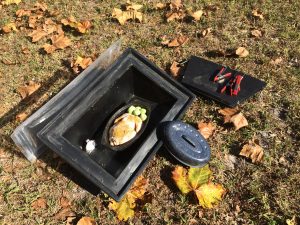
It’s difficult to ruin food in a solar oven.
Should you get a solar oven, or perhaps build one? There are pros and cons. They really are just an insulated black box with a clear plastic cover. Or, you can make one with a black pot, an oven bag and a windshield reflector. There are two down sides to buying one. The first is cost. I paid $135 for mine about thirteen years ago. It comes with a small temperature detector so you can use it to sterilize water. As I have had mine around 13 years that’s about $10 a year. Does it save $10 in electricity per year? Probably if you use it regularly. It’s like using a slow cooker and most recipes for slow cookers work in a solar oven. It’s difficult to over cook with a solar oven. What’s the down side? Over time the plastic cover has warped on my oven, twisted slightly, torque. So to keep it tight it needs a clamp on four sides. And in the winter months when the sun is lower the extra reflection helps keep the temperature up. In that regard the older this oven has a lower the top end temperature than it used to. When new it could easily reach 425 F or so. Now with the clamps and the reflector it reaches about 325 F. That’s okay in that food starts to cook at 185 F. Cooking with a solar oven also requires turning it every hour or so to keep it pointed towards the sun.
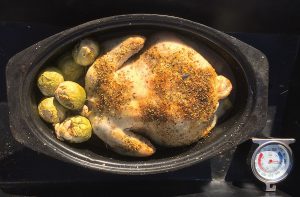
Three hours later…
You can make a wide variety of homemade solar ovens from stationary to portable to inexpensive or costly. A cardboard box stuffed with hay covered by a window works well. Or as mentioned above a dark pot in an oven bag positioned correctly with a reflector works well, too. My old oven will cook a fryer chicken in about three hours on a totally sunny day, longer on partly cloudy day. How can you tell when it’s done? Droplets will condense on the inside of the cover and you will detect the aroma of baked chicken. I bought the oven after the hurricanes of 2004 when we went a total of 15 days without electricity or running water. As mentioned you can not only cook with the oven but sterilize water, too. You can see a video about cooking with a solar oven here.
This is issue 284.
If you would like to donate to Eat The Weeds please click here.


Nice tribute to Sam Thayer’s latest book, Deane. His depth of knowledge and experience is phenomenal. He does set the bar high for the rest of us when it comes to writing about wild edibles and distinguishing them from superficially similar plants.
However, you have an amazing amount of experience with wild edibles, and particularly with the wild edibles to be found in Florida. You may have several books worth of material already written, only needing to be organized and connected. And you have a fine collection of photographs. If you should ever decide to give it a go, let me know. I can recommend a small publishing company that does good work. And I have experience as a technical editor.